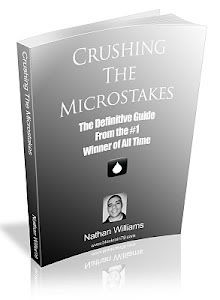Tuesday, 24 April 2012
Book Review: Crushing the Microstakes
As I briefly mentioned in my last post, Nathan Williams sent me his book, Crushing the Microstakes, earlier this year for a review. You can find it on his website at www.blackrain79.com.
Now with my schedule and my mind cleared, I read through it over the past week. It's nice to see some of the smaller stakes online players starting to publish with relevant strategy for micro stakes as opposed to the standard authors that have never played online or online players that play much much higher.
It's a solid 230+ pages plus glossary. The layout is very easy to read and concepts are grouped together well and in logical order. He's generally nailed the his audience with the level of detail and difficulty in the content, that being those trying to become winners at 2NL and 5NL.
He covers pretty much all of the fundamentals: player types, how to identify them and how to play against them, positional awareness and hand selection, cbetting and barreling, 3bet pots, bet sizing, equity, and even a bit of pyschology along with other concepts.
I like the way he's structured his explanation of the more difficult concepts. As a more advanced player I often found myself reading a concept definition and explanation followed by an example, leaving me thinking "That's not all there is too it, there's also _____." And then he followed up the example with the appropriate caveats and addendums to complete the concept. This should make it much easier for beginners to grasp these ideas in small pieces rather than trying to wrap their heads around the entire bit all at once. Nicely done.
I've found with some of the recent ebooks (and even a few in print) that authors are taking full advantage of the platform to promote their site and their affiliations a redundant number of times making me feel as though I'm reading an infomercial. So I'm quite appreciative that Williams put his full disclosures and affiliate links up front and did not mention them again.
I only had two small disagreements with the book:
The first being what I think is an over-statement that he has the most experience and highest winrates at 2NL and 5NL. That may be technically true due to the shear number of hands played, and while his results are very good, I don't think they are extraordinary. I don't believe any of the good 50NL and 100NL regs would have any trouble sustaining the same winrates immediately at those stakes if they dropped down today. I'm of the mindset that logic should stand on it's own, and it certainly does in this book, but posting results is of course expected by the community at large in today's poker climate.
The second was a theoretical issue where he prefers to incorporate a polarized 3bet range into his overall game strategy because it's easy to fold the light end of it while he doesn't want to have to 3bet/fold strong hands like AQs which can't stand a 4bet. He correctly states a few pages later that 4bets are rare due to the passive nature of the game. I would argue that you should have a wide value 3bet range instead of a polarized range in these games because you're often going to get called and you want to have hands where you can value bet often postflop instead of the occasional flopped monster. For example, I would rather 3bet AQs and get value from all the Ax and QT+ that's going to call (along with all the worse suited connectors and low pocket pairs that have to fold postflop) and cold call 76s with massive implied odds on our speculative hands. On the flip side when they do have the nuts and 4bet, everything's a fold anyways and I'd rather 3bet/fold AQs to avoid the reverse implied odds against the top of their range and call with 76s to stack them. I can see how his method would keep newer players out of trouble if they don't have the discipline to fold preflop, but I do think in theory a wide 3bet range is much more profitable.
Other than that I was really impressed with the overall flow of the book and the concise covering of all of the topics a beginner or struggling micro stakes player needs to get on their feet and moving up the ladder towards small stakes. The concepts discussed are the building blocks to a solid game and Williams explains them very well and in context for the games his audience will be playing.
I would highly recommend this book to new players, live players transitioning to online, your friends and family that keep asking you to teach them, and even the intermediate player that is looking for a refresher course to tighten up their game.
Subscribe to:
Post Comments (Atom)




No comments:
Post a Comment